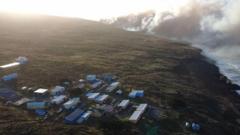For nearly a month, Amsterdam Island, located within the French Southern and Antarctic Lands, has been in the grip of wildfires, threatening its unique biodiversity and scientific research operations. The flames are reported to have affected over half of the island's 54 square kilometers. The region, remote and devoid of permanent inhabitants, serves as a basis for scientific inquiry since the 1980s, particularly in climate and atmospheric studies.
### Amsterdam Island Wildfires: A Scientific and Environmental Catastrophe

### Amsterdam Island Wildfires: A Scientific and Environmental Catastrophe
In an unprecedented incident, wildfires have devastated over 55% of the French-controlled Amsterdam Island in the Indian Ocean, raising alarms about ecological and research implications.
Researchers on the island were forced to evacuate after a fire ignited near a critical observatory on January 15, compromising both their safety and the ongoing research work. Rescue operations successfully relocated 31 personnel to Réunion Island, preventing potential casualties. The loss of life was narrowly avoided as a nearby lobster fishing vessel, which had delayed its departure for a week due to low catch, came to their aid.
Severe weather conditions, such as dry spells and gusty winds up to 40 kilometers per hour, have exacerbated the fire's spread, particularly through the island's network of peat bogs. The resultant damage is significant, with satellite images revealing harm to crucial infrastructure like solar panels, food, and communication lines. Environmentalists worry about the influence on the island's rich biodiversity, including endangered species such as the Amsterdam Albatross and various seals and penguins.
Stepping into action, French authorities have dispatched a reconnaissance team aboard a naval vessel to further evaluate the disaster and secure the affected settlement while determining the blaze's origins. Experts underline that the interruption of atmospheric research marks a troubling event, jeopardizing data collection at this extraordinary research site.
The repercussions of these wildfires will be felt for years, with researchers citing a significant gap in atmospheric data arising from this hiatus. The road to restoration is anticipated to be long and costly, amplifying concerns for the future of both the local ecology and the terrestrial studies that depend on this pristine environment.
In summary, Amsterdam Island’s wildfires signify more than an environmental disaster; they represent a critical juncture in scientific research tied to climate monitoring and biodiversity preservation. The global community watches closely as efforts unfold to recover and restore this unique region.
Severe weather conditions, such as dry spells and gusty winds up to 40 kilometers per hour, have exacerbated the fire's spread, particularly through the island's network of peat bogs. The resultant damage is significant, with satellite images revealing harm to crucial infrastructure like solar panels, food, and communication lines. Environmentalists worry about the influence on the island's rich biodiversity, including endangered species such as the Amsterdam Albatross and various seals and penguins.
Stepping into action, French authorities have dispatched a reconnaissance team aboard a naval vessel to further evaluate the disaster and secure the affected settlement while determining the blaze's origins. Experts underline that the interruption of atmospheric research marks a troubling event, jeopardizing data collection at this extraordinary research site.
The repercussions of these wildfires will be felt for years, with researchers citing a significant gap in atmospheric data arising from this hiatus. The road to restoration is anticipated to be long and costly, amplifying concerns for the future of both the local ecology and the terrestrial studies that depend on this pristine environment.
In summary, Amsterdam Island’s wildfires signify more than an environmental disaster; they represent a critical juncture in scientific research tied to climate monitoring and biodiversity preservation. The global community watches closely as efforts unfold to recover and restore this unique region.



















